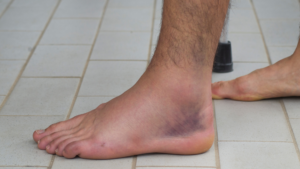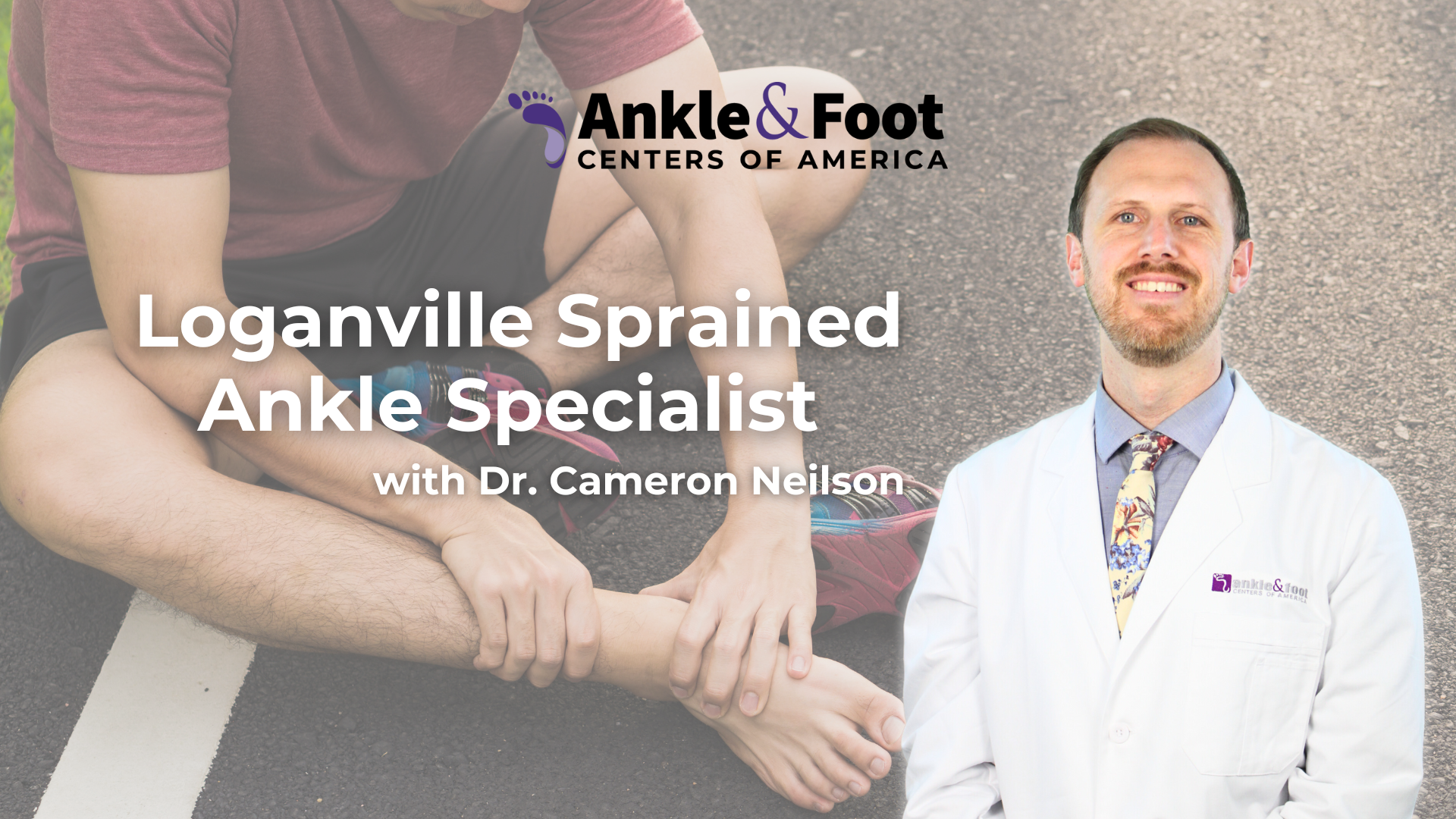Table of Contents
Your Podiatrist in Loganville, GA specializes in treating Sprained Ankles
In Loganville, where sports like Baseball, Basketball, Cross Country, Football, Golf, Lacrosse, Soccer, and Softball thrive. Sports injuries, such as a sprained ankle, encompass a broad spectrum of physical ailments arising during athletic activities or exercise. These injuries have the potential to impact various parts of the body, including muscles, ligaments, tendons, and bones. Engaging in sports is undeniably an excellent avenue for maintaining physical fitness and overall well-being.
Understanding sprained ankles requires a keen awareness of the mechanisms that give rise to these injuries, their prevalence across different athletic disciplines, and the potential impact on athletes’ performance, careers, and long-term health. Whether dealing with minor sprains or more severe fractures, sports injuries stand as a significant concern for athletes and sports enthusiasts participating in the diverse array of sports that define the sporting landscape in Loganville.
Common Sports Injuries
 Engaging in sports activities brings joy and fulfillment, but it also exposes individuals to a variety of potential injuries. These injuries can range from minor setbacks to more severe conditions that may require extensive rehabilitation. Here is a brief overview of some of the most common sports injuries:
Engaging in sports activities brings joy and fulfillment, but it also exposes individuals to a variety of potential injuries. These injuries can range from minor setbacks to more severe conditions that may require extensive rehabilitation. Here is a brief overview of some of the most common sports injuries:
Sprained Ankle
Definition: A sprained ankle occurs when the ligaments that support the ankle are stretched or torn, usually as a result of sudden twisting or rolling of the foot.
Causes: Common causes include uneven surfaces, improper footwear, or sudden changes in direction during athletic activities.
Strains and Pulls
Definition: Strains involve the stretching or tearing of muscles or tendons, commonly occurring due to overexertion or improper technique.
Causes: Repetitive or forceful movements, lack of proper warm-up, and muscle imbalances can contribute to strains and pulls.
Fractures and Breaks
Definition: Fractures involve the breaking of bones, often resulting from high-impact collisions, falls, or direct trauma.
Causes: High-velocity impacts, accidents, or collisions with other athletes or objects can lead to fractures.
Dislocations
Definition: Dislocations occur when the bones in a joint are forced out of their normal positions.
Causes: High-impact forces or awkward landings can lead to joint dislocations.
Symptoms: Intense pain, swelling, and visible deformity are indicative of joint dislocations.
Understanding Sprained Ankles
Definition and Causes: A sprained ankle is a common sports injury characterized by damage to the ligaments that connect the bones of the ankle joint. This injury often occurs when the ankle is twisted or turned beyond its normal range of motion. Ligaments, which are tough bands of tissue, are responsible for stabilizing the joints, and when they are stretched or torn, a sprain occurs.
Causes of Sprained Ankles: The causes of sprained ankles vary but are frequently linked to sudden changes in direction, uneven surfaces, or awkward landings during physical activities such as running, jumping, or playing sports. High-impact sports like basketball, soccer, and tennis are particularly prone to ankle sprains due to the dynamic movements involved.
Risk Factors for Sprained Ankles
Several factors increase the likelihood of experiencing a sprained ankle. These include a history of previous ankle injuries, inadequate warm-up before physical activity, improper footwear, and participating in sports with a high risk of ankle injuries. Additionally, individual factors such as age, muscle weakness, and joint laxity can contribute to susceptibility.
Athletes, especially those engaged in competitive sports, need to be aware of these risk factors to take appropriate precautions and minimize the chances of sustaining a sprained ankle.
Loganville, GA Patients Have a Sprained Ankle Specialist for Sports Injuries
Effective management of sprained ankles relies heavily on timely diagnosis and intervention. Disregarding or neglecting a sprain can result in complications, prolonged recovery periods, and an elevated risk of re-injury. For specialized care in managing sprained ankles in Loganville, individuals can turn to Dr. Neilson, a distinguished sprained ankle specialist, ensuring a comprehensive and tailored approach to recovery.
Signs and Symptoms
 Recognizing the Indications of a Sprained Ankle: Identifying the signs and symptoms of a sprained ankle is crucial for prompt intervention and effective recovery. Athletes and individuals engaged in physical activities should be vigilant about the following indicators:
Recognizing the Indications of a Sprained Ankle: Identifying the signs and symptoms of a sprained ankle is crucial for prompt intervention and effective recovery. Athletes and individuals engaged in physical activities should be vigilant about the following indicators:
- Pain: A sudden onset of pain, particularly on the outer side of the ankle, is a common symptom of a sprained ankle. The intensity of pain may vary depending on the severity of the injury.
- Swelling: Swelling around the ankle joint is a typical response to a sprain. The affected area may appear visibly swollen, and the skin might feel warm to the touch.
- Bruising: Discoloration or bruising may develop, indicating damage to blood vessels and tissues. The bruised area may spread from the ankle down to the foot.
- Limited Range of Motion: A sprained ankle can result in decreased flexibility and difficulty moving the affected foot. Athletes may find it challenging to perform routine movements like walking or running.
- Tenderness to Touch: The injured area may be sensitive to touch, and athletes might experience discomfort or pain when pressure is applied to the affected ligaments.
Severity Levels and Their Implications
Sprained ankles are often categorized into three grades based on the severity of the ligament damage:
- Grade I (Mild): Involves minor stretching or microscopic tearing of the ligaments. Athletes may experience mild pain and swelling but can usually bear weight on the affected foot.
- Grade II (Moderate): Indicates partial tearing of the ligaments, leading to more significant pain, swelling, and bruising. Athletes may have difficulty bearing weight and may notice increased instability.
- Grade III (Severe): Involves a complete tear or rupture of the ligaments. This is a more serious injury, often accompanied by intense pain, severe swelling, and substantial functional impairment. Weight-bearing is typically not possible without significant discomfort.
R.I.C.E. Method (Rest, Ice, Compression, Elevation)
When confronted with a sprained ankle, immediate care is paramount to minimize swelling, alleviate pain, and promote a speedier recovery. The R.I.C.E. method is a widely recognized approach:
- Rest: Allow the injured ankle to rest by avoiding weight-bearing activities. Immobilizing the ankle helps prevent further damage to the ligaments.
- Ice: Apply ice to the affected area to reduce swelling and numb pain. Ice can be wrapped in a thin cloth and applied for 15-20 minutes every 1-2 hours during the initial 48 hours.
- Compression: Use a compression bandage to gently wrap the injured ankle. Compression helps control swelling and provides support to the injured tissues.
- Elevation: Elevate the injured ankle above the level of the heart whenever possible. This aids in reducing swelling by allowing fluids to drain away from the injured area.
Where to Find a Loganville Podiatrist who Specializes in Sprained Ankles?
While the R.I.C.E. method (Rest, Ice, Compression, Elevation ) can effectively treat many mild to moderate ankle sprains at home, it is crucial to identify scenarios that necessitate professional medical attention. Seeking timely care is paramount to preventing potential complications and ensuring the injury is properly managed. If you are in Loganville, GA, and experiencing a sprained ankle, there is now a specialist you can rely on. Schedule a consultation with Dr. Neilson if:
- Severe Pain or Swelling: If pain and swelling persist or worsen despite at-home care, consulting a healthcare professional is advisable.
- Inability to Bear Weight: If walking or putting weight on the affected ankle is impossible, medical evaluation is necessary to assess the extent of the injury.
- Changes in Skin Color or Temperature: If the skin around the ankle becomes pale, blue, or unusually cold, it may indicate a more severe injury requiring medical attention.
- Noticeable Deformity or Swelling: Any visible deformity, such as a misshapen ankle joint, or excessive swelling may indicate a more severe injury that requires professional assessment.
- Limited Range of Motion: If you have difficulty moving the ankle or experience a significant reduction in flexibility.
- Previous History of Ankle Injuries: Individuals with a history of recurrent ankle sprains or those who have not fully recovered from a previous injury should seek professional guidance to prevent further complications.

Conclusion
In conclusion, acquiring a comprehensive understanding of sports injuries, particularly the prevalent and often underestimated sprained ankle, is vital for athletes aiming to safeguard their well-being and ensure longevity in their chosen sports. We’ve delved into the causes, symptoms, and severity levels associated with sprained ankles, emphasizing the importance of prompt diagnosis and appropriate treatment.
Athletes in Loganville and beyond are urged to prioritize injury prevention as an integral part of their training regimen. This involves adopting warm-up routines, wearing proper footwear, and being mindful of potential risk factors during physical activities. Prevention stands as the primary defense against sports injuries, and the investment in proactive measures can significantly contribute to a prolonged and successful athletic career.
As we wrap up, it’s crucial to highlight the expertise available in Loganville for athletes grappling with sprained ankles. Dr. Neilson, a renowned sprained ankle specialist, provides specialized care and treatment tailored to the unique needs of each patient. Seeking timely medical attention from a qualified professional like Dr. Neilson ensures an accurate diagnosis and an effective treatment plan for a swift and successful recovery.
Athletes experiencing a sprained ankle in Loganville can trust Dr. Neilson for sprained ankle treatment, knowing that they are in capable hands. By addressing sports injuries promptly and with the guidance of a specialist, athletes can not only recover faster but also minimize the risk of long-term complications.
FAQs for Sports Injuries, Including Sprained Ankles
Should I go to the doctor for a sprained ankle?
Yes, it is advisable to consult a healthcare professional for a proper diagnosis and appropriate treatment for a sprained ankle.
When should I see a doctor for a sprained ankle?
If you experience persistent pain, swelling, bruising, or difficulty bearing weight on the affected foot, it is recommended to see a doctor promptly for evaluation.
 Should I see a podiatrist or orthopedist for foot pain?
Should I see a podiatrist or orthopedist for foot pain?
Both podiatrists and orthopedists specialize in treating foot and ankle conditions. It is often recommended to start with a podiatrist, but if necessary, they may refer you to an orthopedist for further evaluation.
Does a podiatrist treat ankles?
Yes, podiatrists specialize in sprained ankles along with the diagnosis and treatment of many other conditions affecting the foot and ankle.
When to see a doctor for a sprained ankle?
Seek medical attention if your sprained ankle symptoms do not improve with home care, or if you experience severe pain, instability, or inability to bear weight
About the Author: Cameron Neilson, DPM
Dr. Neilson is a highly qualified and dedicated specialist in the field of podiatric medicine. His educational journey has equipped him with the knowledge and expertise to address sports injuries, with a particular focus on the often underestimated sprained ankle.
Starting his academic pursuit at Brigham Young University in Provo, Utah, Dr. Neilson laid the foundation for academic excellence during his undergraduate studies. Following this, he earned his medical degree from the College of Podiatric Medicine at Samuel Merritt University in Oakland, California. This rigorous academic background provides him with a solid foundation in podiatric medicine, preparing him to offer comprehensive and specialized care to his patients.
To further hone his skills and gain practical experience, Dr. Neilson completed his residency at Emory Healthcare in Decatur, GA. This residency program afforded him the opportunity to work in a diverse healthcare setting, enhancing his ability to diagnose and treat a wide range of podiatric conditions, including sports injuries like sprained ankles.
Dr. Neilson’s commitment to excellence extends beyond his education and practical training. He holds certifications that underscore his expertise in the field, being board-certified in Podiatric Medicine. This certification serves as a testament to his dedication to meeting the highest standards of professional practice, ensuring that patients receiving care from Dr. Neilson can trust in his qualifications and unwavering commitment to their well-being.


 Should I see a podiatrist or orthopedist for foot pain?
Should I see a podiatrist or orthopedist for foot pain?


